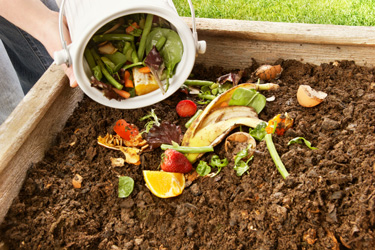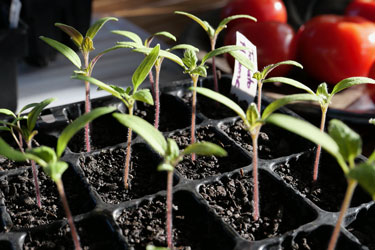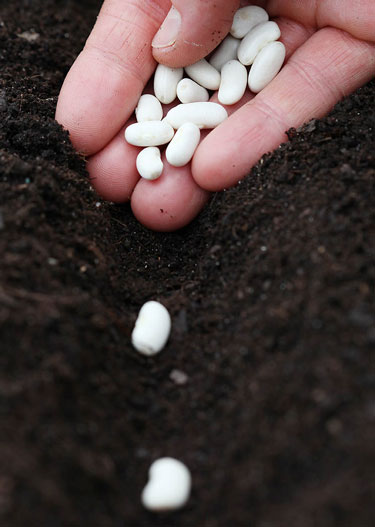Spring in the vege patch
12 timely tasks and seed sowing tips to get the best in your vege patch
| 1 | Enrich the root zone. Add a generous helping of compost to all vegetable beds before planting or as a mulch beside plants. Now is a great time to start that home compost heap or worm farm. |
| 2 | Build a plant cage. A multipurpose frame can be used to protect from cold weather in spring and pesky flying insects as the weather warms into summer. Be ready with frost cloth to protect vulnerable crops, such as young vege seedlings and citrus. Once spring growth starts, soft young shoots can be at risk in a cold snap. |
| 3 | Start tomatoes and peppers. Enjoy the satisfaction that comes from growing your own plants from scratch. In many areas it’s too cold to plant tomatoes, peppers or eggplants outdoors until mid to late October, but seedlings of these tasty summer crops can be started in pots for planting out later. Seedlings grown indoors need to be ‘hardened off’ before they are planted in the garden. Gradually acclimatise seedlings before planting by moving them outside in their containers during the day. |
| 4 | Sow or plant cucurbits. Zucchini, pumpkins, cucumbers and squash seedlings are ready in garden centres to be planted out once the soil has reached at least 16˚C. There is no point in sowing or planting outdoors too early. A young cucumber or zucchini plant will sit and sulk in cold soil, while the same sized seedling planted a week or two later will soon catch up and overtake it. Once the soil is warm these veges can be sown directly into the garden. Alternatively, sow some seeds in pots to keep them warm then transplant later into warm garden soil or big pots. HINT: To help raise soil temperature, spread black plastic over your planting area two or three weeks prior to planting. |
| 5 | Grow your own potatoes. Fun to grow in garden beds or large containers, both early crop (summer harvests) and main crop (autumn harvests) varieties are available for planting in September. Try an early variety to harvest within 100 days plus a main crop for later. |
| 6 | Sow a row of root veges. Lightly sprinkle seeds of radishes, carrots, beetroot or parsnips into a sunny patch of well-drained soil that’s loose and crumbly without lumps. Wait until the soil has warmed to 10℃. Don’t add fertiliser at this stage, as high nitrogen levels cause forked roots. Ideally sow carrots or parsnips where a well-fed crop of leafy greens grew the season before. Water gently and keep the soil evenly moist. Once the seedlings are 3-5cm tall it’s time to start thinning them out. Leave about 2-3cm between each seedling. As the plants grow, thin them some more and eat the thinnings. Do not let the soil dry out. TIP: An easy way to thin seedlings is to simply snip the excess seedlings off at the base with scissors. The roots will die off without disturbing the remaining seedlings. |
| 7 | Sow pea seeds while the weather is cool. Peas, snow peas and sweet peas grow best when started from seed sown directly into cool, compost enriched soil in autumn or spring. Sow seed next to a support structure, such as a simple teepee made from bamboo stakes. Peas can also be grown in large containers. |
| 8 | Sow beans. Beans grow best when seed is sown straight into warm garden soil, at least 18℃. For climbing beans install a support structure before sowing. It could be a wire frame on a fence or a bamboo teepee. Dwarf beans mature very quickly to produce the bulk of their crop over a two to three-week period. Climbing beans take longer to mature, but plants produce higher yields per square metre and will keep on producing until the first frost. To achieve a non-stop supply of dwarf beans, sow another batch of seeds every three weeks until January. |
| 9 | Sow or plant herbs. Spring onions and herbs can be direct sown outdoors or in trays for planting out later. Coriander grows best in spring, before hot weather causes plants to bolt to seed. |
| 10 | Start a spring salad garden. Kick-start a healthy spring diet with quick growing lettuces, rocket, radish, spinach and kale. Salad greens thrive at this time of year in moist well-composted soil or container mix that is kept well fed and watered. |
| 11 | Keep soil covered. Apply organic mulch, such as compost or straw around vegetable plants. It will block the weeds and conserve soil moisture while breaking down into humus, the foundation of healthy soil life. While not as pretty as pea straw, even wilting weeds, laid on the soil surface after you pull them, make an effective soil cover. |
| 12 | Beware of marauding molluscs. Slugs and snails get active in warm wet weather. One midnight feast can annihilate precious young seedlings. It’s time to guard against these slimy pests. |
Seed Sowing Tips
- Always read the seed packet. Different seeds have different needs. Open the packet from the bottom so you don’t lose important information.
- Use a soil-less seed raising mix to avoid soil-borne pathogens. Don’t use potting mix as this contains fertiliser and lumpy bits, which are a hindrance to germination success.
- Before sowing the seed, pre-wet the mix and leave trays to drain.
- After sowing keep the mix just moist (not wet). Spritz with a mist spray bottle - only when the mix is dry to touch.
- Placing a seed tray inside a plastic bag creates warm conditions similar to a green house. Alternatively, cover seed trays with a sheet of glass (wipe the underside of the glass daily to remove condensation).
- The planting depth relates to the size of the seed. As a general rule a covering two to four times the seeds depth is needed. Small seeds like basil or petunias can be left uncovered. Just press them into the mix with your fingers.
- Label every batch of seed you sow. You will forget what you planted where!
- Some plants don’t like being shifted and are best sown ‘direct’ to eliminate transplanting shock. Examples of seeds that are best sown in situ are coriander, peas, carrots and other root crops.
- Sow rows of quick maturing veges (such as lettuces and radishes) between rows of slow growing crops (like carrots and parsnips). This is a useful way to mark the rows also makes good use of space before the larger crops fill the space.
- When direct sowing vegetable seeds like sweet corn, zucchini, peas and beans, sow two or three seeds at each station, removing the weakest after germination.

15-Sep-2022

Make compost from kitchen scraps

Make a tunnel cloche from frost cloth to protect tender plants

Tomato seedlings grown indoors

Cucurbit seedlings

Carrot seedlings, sown direct in the ground, ready for thinning.

Sowing bean seed

Straw mulch. A mulch protects the soil, retains moisture in the soil and discourages weeds.

Label the seeds you sow!

